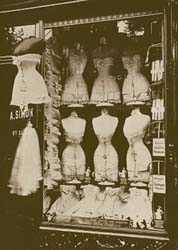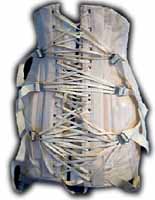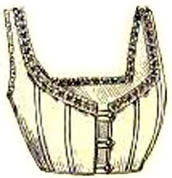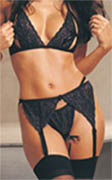In looking through the history of human sexuality, we notice that most of all aspects of our daily routine seemingly influence directly on our sexual demeanors. Fashion is an excellent example for crying out loud. The ways people dress and behave through the ages further reflect the thoughts and opinions of each particular time warp. As we look back on the history of lingerie interesting details on sexual preferences and customs come to light. From using whalebones inside corsets, to feminists burning their bras, and then, to today's light and sexy lingerie, a lot has changed.
Basically, undergarments
were created to emphasize the silhouette by shaping up breasts, waist and hips
with the sole purpose of rendering the female
figure more attractive. The first recorded corset comes from Crete and dates
back 3000 years ago. At that time, it wasn't only a piece of clothing
but already an ornament, being adorned sometimes with a pin or a brooch. Later
on in Greece, fabrics made of leather and woolen hit the mainstream.
|
|
Throughout
medieval times, oppressed by myths and religious customs,
people denied their sexuality
by hiding under drapes as heavy as shapeless made of fabric
grain. Although people usually picture out that era as somewhat
poetic in that princesses wearing beautiful silk dresses
and knights in lustrous armor, fashion was something useless
in a time whose clothes would've been plain and functional.
Influenced by Spanish style, the corset was then reinvented
as designed to shape a very small waist and so as to elongate
the woman's torso. The corset was an exclusivity of
aristocracy, which is no surprise if we remember that the
medieval average woman was secluded down to home chores
and children nurturing. The first corset was actually made
of hinged iron armour. At the end of the 16th Century, materials
such as whalebone, wood, and flexible steel started to be
used creating a "comfortable" version of the corset.
|
| Several
materials as well as styles were employed in versions of the
corset that followed until Renaissance, when women
were practically trussed within their corsets in order to
achieve wasp-like shape on the verge of unnatural. Internal
organs were squeezed, ribs were practically pushed out of
shape and women could barely breath, even passing out sometimes.
They actually needed help from others to cinch their corsets
tight enough. Such custom seem somewhat shocking for today's
standards, but let's not forget that today's girls
also subject themselves to extreme physical alterations for
the sake of beauty and glamour. |
|
|
| The
18th century, which is considered by many as one of the sexiest
times of our history, was characterized by the use of lighter
fabrics, so the corsets had more color, decorated with ribbons,
pins, laces and all kinds of fancy ornamentation. They were
designed to draw all the attention to breasts, pushed up inside
showing beautiful and lustful cleavages. At that time, the
shaping of the silhouette due to the use of tight corsets
started to be disapproved by doctors. So the corset had only
the function of emphasizing the breasts, and systems that
allow a woman to put on her own corset were developed. At
the beginning of the 19th century, someone had the ingenious
idea of cutting of the midriff of a corset to allow more movement
to the body and extra support to the breasts, creating the
brassiere (which is French for support).
The
lingerie industry started to grow up very fast and the bra
became a common accessory for every women finding its place
during World War I, when clothes needed to be light and
cool enough for factories work. From then on, the styles
started to change as the fashion comes and goes in cycles.
The boyish look from the Flappers in the Twenties brought
chemises, bloomers and light and loose fitting underwear,
being replaced by a figure of a well-proportioned and feminine
woman in the 30's. The creation of Laxtex by Dunlop Rubber
was a remarkable advancement, allowing industry to make
lingerie in different sizes to fit in each woman's shape.
|
| The
movement of feminism during the 60's led women to literally
burn their bras in public for the sake of equality of genders.
At the same time that bras were not woman's favorite accessory,
legs were on the spot and mini-skirts becoming popular. The
invention of Lycra gave women the opportunity to bring attention
to legs with the first stockings.
Today
we have plenty of styles and models made by several different
materials, to fit not only on each woman's body but also
her desires and intentions. The purposes of the lingerie
still the same - to make women more attractive - the only
thing that has changed is fashion. The lingerie reflects
the ideas of the times we're living in, where people feel
free to express desires and preferences in bed. |
| | |
|




